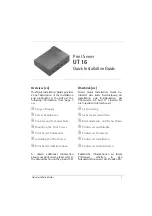
Use the information in this table to determine the number of cells that require
reengineering.
Determining cell reengineering
Table 12: Example of a completed estimate table
Estimate for:
1C1
1C2
1C3
1C4
1C5
1C6
1C7
Users inside the cell with
an office
8.4
0.7
21.0
14.7
0.7
4.9
2.1
Users with an office
outside of a cell who walk
into the cell
3.2
3.7
2.3
2.7
3.7
3.4
3.6
Users without an office
0
0
0
0
0
0
0
Users in a cell
11.6
4.4
23.3
17.7
4.4
8.3
5.7
Table 13: Example of a completed telephone types table
Telephone type
1C1
1C2
1C3
1C4
1C5
1C6
1C7
User telephone types
H&W
H&W
M
M
H&W
H&W
H&W
Table 14: Cell reengineering
Estimate for:
Users with both a
handset and a wired
telephone
Users with only a handset
Action
From 0 up to 20
From 0 up to 12
Keep cell size as deployed.
Greater than 20
Greater than 12
Subdivide the cell
a
to meet the
preceding conditions.
a
. For information about how to subdivide cells, see
High handset density deployment
on
page 71.
Use
on page 68 only for user types H&W and H. For user type M
A mix of users with and without wired telephones in a cell
on page 69.
Determining cell reengineering
1. Find the number of users for users in the first cell.
In the example shown in
Table 12: Example of a completed estimate table
page 68, the handset estimate is 11.6.
2. Determine the telephone types in the first cell.
In the example shown in
Table 12: Example of a completed estimate table
page 68, the telephone type is H&W.
Site planning and hardware deployment
68 SIP DECT Fundamentals
October 2012
Summary of Contents for CS 1000
Page 6: ...6 SIP DECT Fundamentals October 2012 ...
Page 146: ...System administration 146 SIP DECT Fundamentals October 2012 Comments infodev avaya com ...
Page 174: ...System maintenance 174 SIP DECT Fundamentals October 2012 Comments infodev avaya com ...
Page 204: ...Site survey example 204 SIP DECT Fundamentals October 2012 Comments infodev avaya com ...
















































